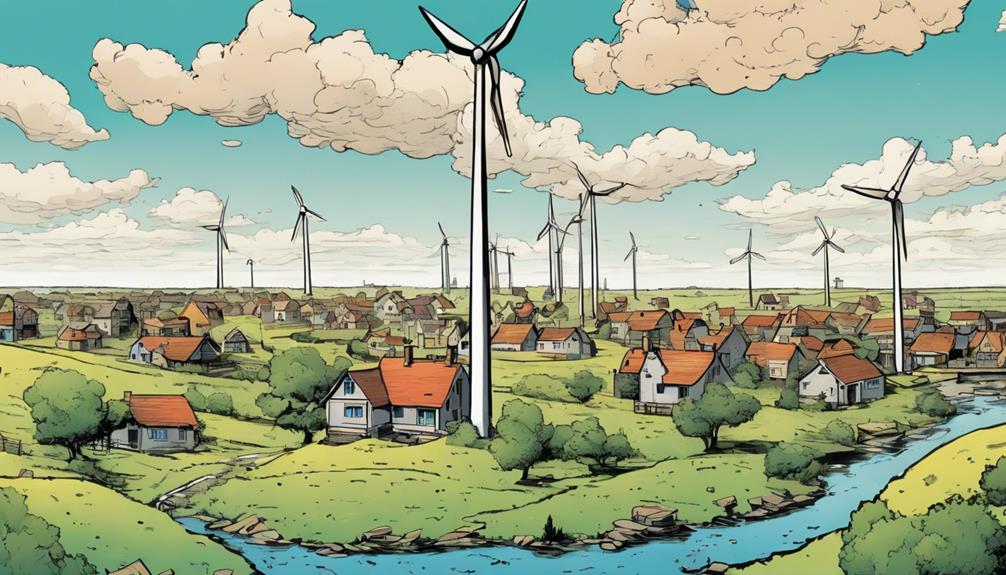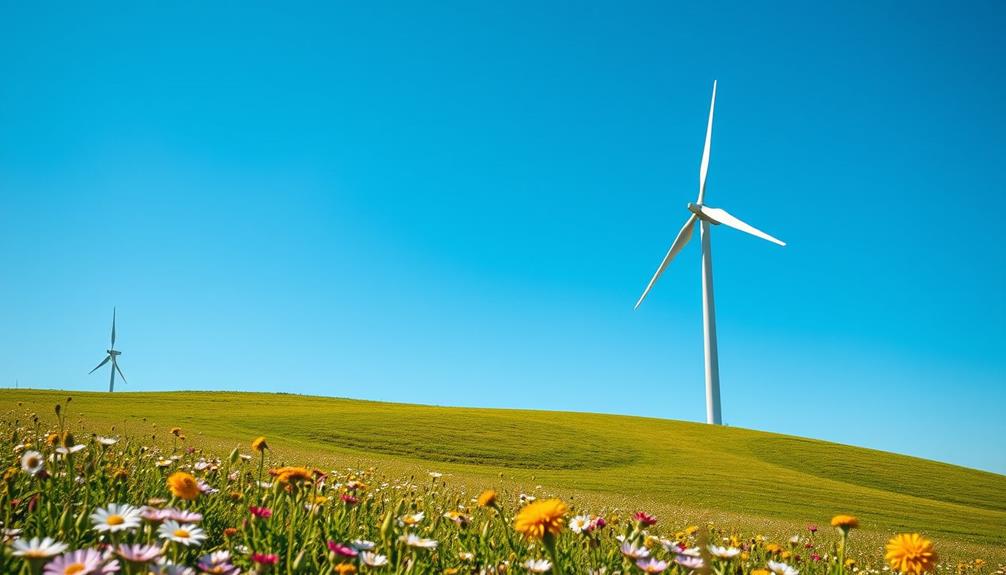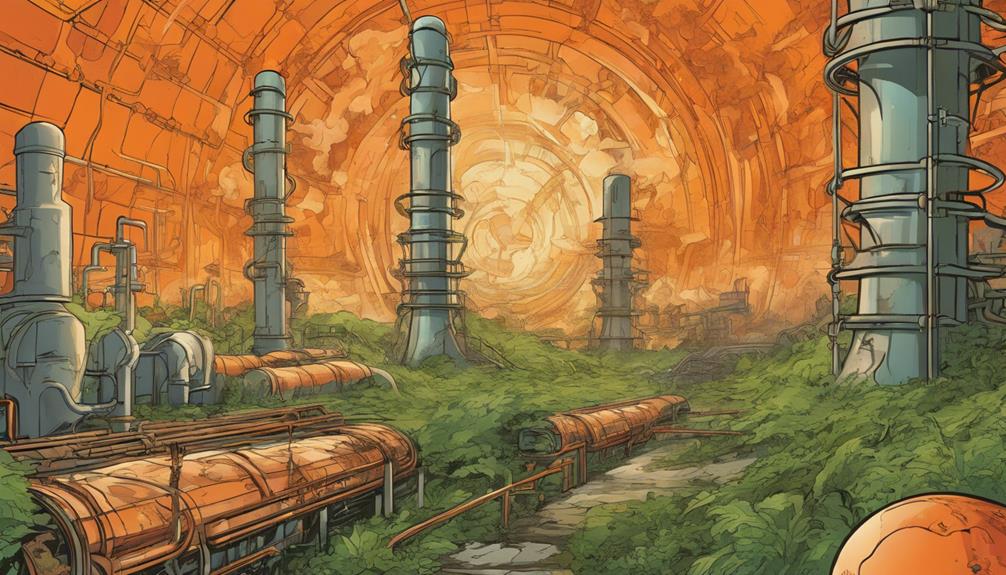You'll be surprised to learn that a single modern wind turbine can power anywhere from 400 to 3,600 American homes, depending on its size and the wind speeds it harnesses. The larger the turbine, the more homes it can power. For instance, a 1.5 MW turbine can supply electricity to around 400 American homes, while the massive GE Haliade-X can power up to 3,600 homes. But that's not all – there's more to the story of wind turbines and their incredible potential to power our lives.
Key Takeaways
- A 1.5 MW wind turbine can power around 400-415 American homes per month.
- The GE Haliade-X turbine can power up to 3,600 American homes.
- Over 318,000 1.5 MW turbines would be needed to power the entire US residential sector.
- On average, a wind turbine can produce enough electricity to power around 1,400 homes per year.
- Larger turbines used in wind farms can collectively power millions of homes.
Understanding Wind Turbine Basics
You'll first need to understand that wind turbines operate on a simple yet powerful principle: converting the kinetic energy of the wind into electrical energy. This energy is then used to power homes, making wind turbines an essential part of renewable energy production.
The amount of energy a wind turbine can generate depends on its capacity factor, which takes into account the average wind speed at its location.
When the wind speed is high, the turbine's capacity factor increases, allowing it to generate more power. However, even at slower wind speeds, modern wind turbines can still produce a significant amount of energy.
On average, a single wind turbine can power hundreds of homes. For instance, a typical 1.5 MW wind turbine can power around 300-400 American homes per month. Larger turbines, like the GE Haliade-X, can power thousands of homes, up to 3,600 per turbine.
As you can see, wind turbines play a significant role in providing clean energy to homes, and understanding their basics is vital to appreciating their impact.
Factors Affecting Power Output
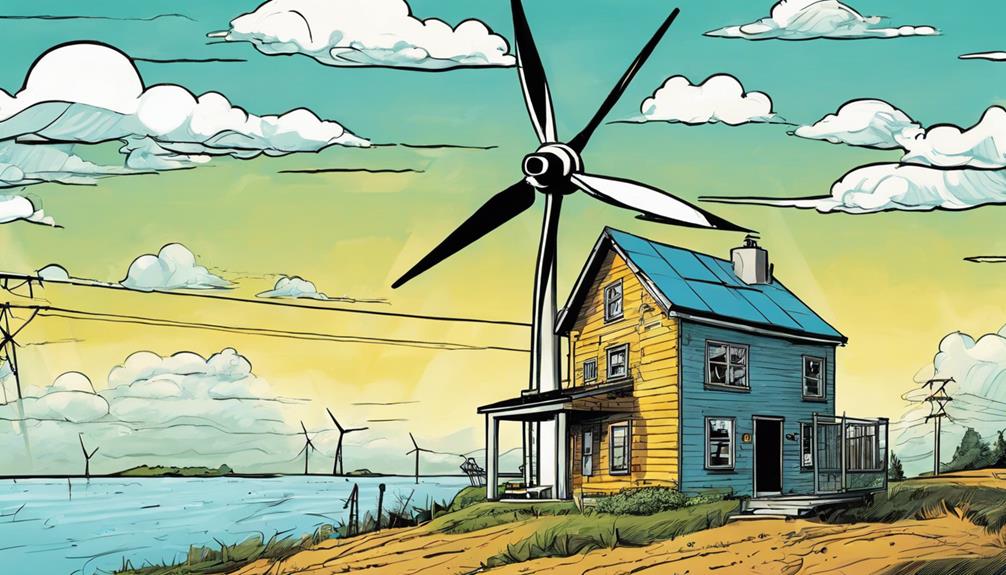
As you consider powering your home with a wind turbine, understanding the factors that affect its power output is crucial.
You'll soon discover that wind speed matters – a lot – and that turbine size has a significant impact on the amount of electricity generated.
Wind Speed Matters
Frequently, homeowners considering wind-powered homes wonder how wind speed impacts their energy production. The answer is simple: wind speed matters. The power output of a wind turbine is directly influenced by the wind speed it encounters. Higher wind speeds result in increased energy production from a wind turbine.
Here are some key wind speed facts to keep in mind:
- Cut-in speed: A minimum wind speed of around 9 mph is required for a wind turbine to start generating electricity.
- Best range: The best wind speed range for maximum energy production is typically between 30 and 55 mph.
- Cut-out speed: Turbines will stop generating electricity at extremely high wind speeds to prevent damage.
Understanding these wind speed factors is essential for homeowners to maximize their energy production. By installing a wind turbine in an area with consistent wind speeds within the best range, you can achieve a significant increase in your power output.
Turbine Size Impacts
Now that you've considered the impact of wind speed on your energy production, it's time to think about the other vital factor: the size of your wind turbine. You'll find that turbine size notably impacts the number of homes it can power.
For instance, a 1.5 MW turbine can typically power around 415 American homes per month, showcasing the influence of turbine size on energy generation.
Larger turbines, like the GE Haliade-X, have an even greater capacity, able to power approximately 3,600 American homes. This highlights the potential of larger turbines in energy supply.
To put this into perspective, to power the entire US residential sector, you'd need over 318,000 turbines rated at 1.5 MW. In Europe, it would take around 161,000 turbines of the same size to power all households.
It's clear that turbine size plays a vital role in energy generation. As you consider investing in wind energy, keep in mind that larger turbines can make a notable difference in the number of homes you can power. With the right turbine size, you can make a substantial impact on the residential sector's energy supply.
How Many Homes Can It Power
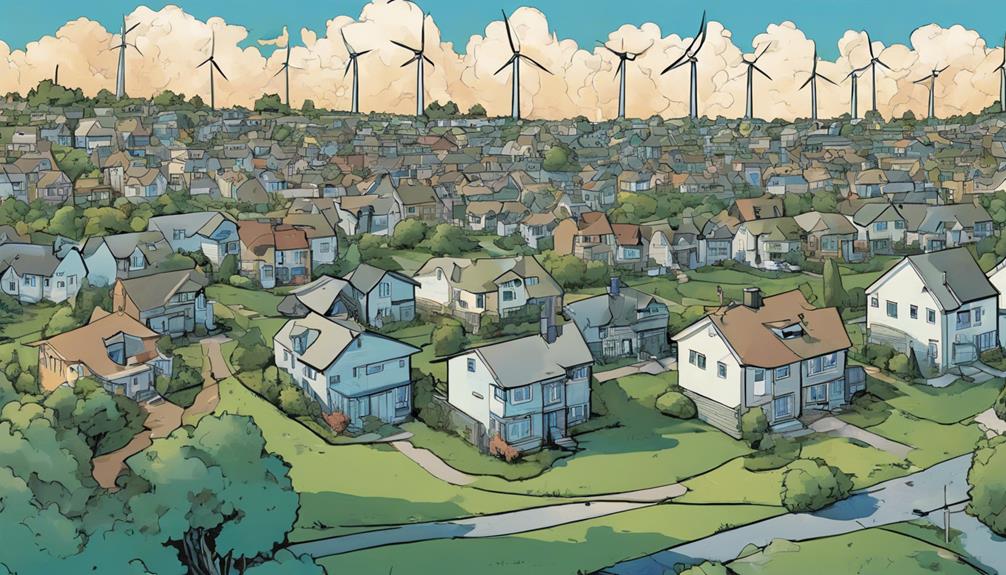
By the end of the month, a single 1.5 MW wind turbine can supply electricity to around 400 American homes. That's a significant amount of energy, considering the average American home consumes around 900 kWh of electricity per month.
But what if you want to power more homes? Larger turbines like the GE Haliade-X can power up to 3,600 American homes, making them a more efficient option.
Here are some additional facts to put things into perspective:
- To power the entire US residential sector, over 318,000 1.5 MW turbines would be needed.
- In Europe, approximately 161,000 turbines rated at 1.5 MW would be required to power all households.
- Wind farms, consisting of multiple turbines, can collectively power millions of homes, with offshore farms using larger, more powerful turbines.
As you can see, wind turbines have the potential to generate a significant amount of energy and power thousands of homes.
According to the Wind Turbine Database, the average turbine can produce enough electricity to power around 1,400 homes per year. With the growth of wind energy, it's likely that more homes will be powered by wind turbines in the future.
Wind Turbine Capacity and Growth

As you explore the world of wind-powered homes, you're likely curious about the capacity of these turbines and how they're growing to meet energy demands.
You'll want to ponder the power output of individual turbines, how wind speeds impact their performance, and their overall energy generation capacity.
Turbine Power Output
With the increasing demand for renewable energy, you're likely wondering how much power a single wind turbine can generate. The answer lies in its capacity, which has seen significant growth in recent years.
A standard 1.5 MW wind turbine, for instance, can power around 415 American homes per month. However, larger turbines like the GE Haliade-X have the capacity to power approximately 3,600 American homes.
Here are some key facts about wind turbine power output:
- A single 1.5 MW turbine produces enough electricity to power 415 homes monthly.
- To power the entire residential sector in the United States, you'd need over 318,000 1.5 MW turbines.
- Offshore wind farms utilize larger, more powerful turbines to generate electricity for a significant number of homes.
As the energy industry shifts towards renewable sources, understanding wind turbine power output is vital. With the capacity to power thousands of homes, wind turbines are becoming an increasingly important part of our shift to cleaner energy.
Wind Speed Impact
You're likely wondering how wind turbines can consistently generate power, and the answer lies in their ability to harness wind energy efficiently, which is directly tied to wind speed. As you might expect, higher wind speeds lead to increased electricity production. In fact, advances in wind turbine technology have made them more efficient at capturing wind energy, contributing to the growth of wind power capacity.
Turbines are designed to operate within specific wind speed ranges to optimize energy output and protect the equipment from damage during high wind conditions. The capacity factor of a wind turbine, which considers the average wind speeds at a site, is a pivotal factor in estimating the amount of power it can generate over time.
When wind speeds increase, the capacity factor also rises, resulting in more consistent and reliable electricity production from wind turbines. This means that wind turbines can produce power more consistently, making them a more viable source of renewable energy.
Energy Generation Capacity
Wind turbines boast impressive energy generation capacities, ranging from a single 1.5 MW turbine powering around 415 American homes per month to massive offshore wind farms harnessing millions of homes' worth of electricity. As you explore the world of wind energy, you'll discover that larger turbines like the GE Haliade-X can power around 3,600 American homes.
To put this into perspective:
- To power the entire US residential sector, over 318,000 turbines rated at 1.5 MW would be needed.
- In Europe, approximately 161,000 turbines at 1.5 MW would be required to power all households.
- Wind farms, consisting of multiple turbines, can collectively power millions of homes, with offshore wind farms using larger, more powerful turbines.
You can see that wind turbines have significant energy generation capacities, making them a viable option for powering homes. As the demand for renewable energy grows, wind farms will continue to play an essential role in meeting the electricity needs of the residential sector.
With their impressive power capacity, wind turbines are an integral component in the journey towards a more sustainable future.
Powering a Country With Wind
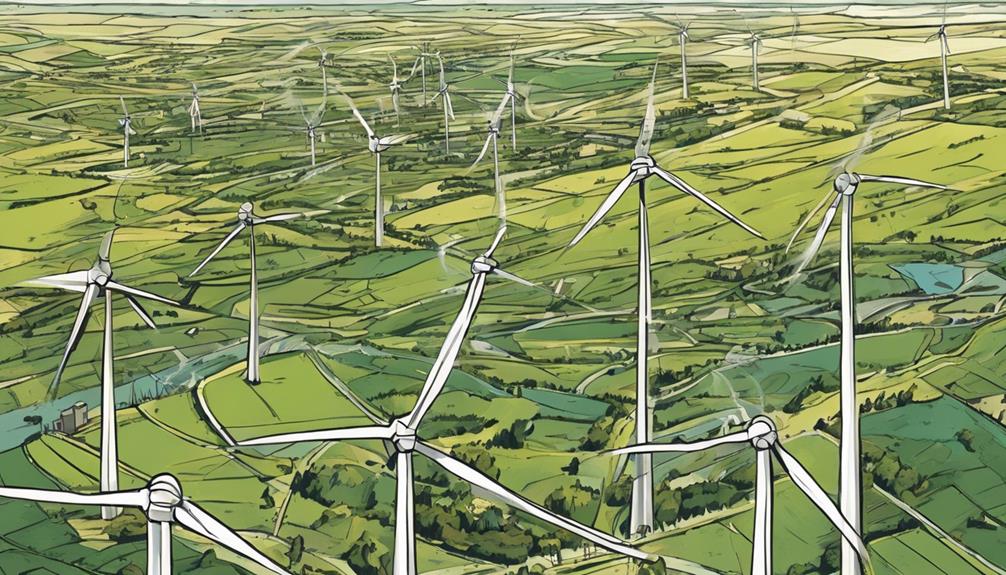
Approximately 318,000 turbines rated at 1.5 MW would be required to power every American home, a challenging number that underscores the immense scale of wind energy needed to meet the country's residential power demands.
You might wonder, is it even possible to power an entire country with wind? The answer is yes, but it would take a significant effort. In the US, you'd need over 318,000 turbines, while in Europe, around 161,000 would be required to power all households.
Wind farms, consisting of multiple turbines, can collectively power millions of homes. Offshore wind farms, in particular, use larger, more powerful turbines for increased energy production. To put this into perspective, a single 1.5 MW turbine can power around 415 American homes per month.
Imagine the capacity of hundreds of thousands of turbines working together to power an entire country! While it's a challenging task, it's not impossible. With continued advancements in wind turbine technology and energy production, powering a country with wind might become a reality sooner than you think.
Wind Farm Energy Production

Hundreds of homes can be powered by a single wind turbine, and when grouped together in a wind farm, the energy production capacity increases exponentially. As you explore the world of renewable energy, you'll discover that wind farms are an essential part of the wind industry. These clusters of turbines power even more homes collectively, with large onshore wind farms like the Gansu Wind Farm in China able to power over 2.6 million US homes.
Here are some key facts about wind farm energy production:
- Offshore wind farms, like the Hornsea 1 wind farm, can power about 400,000 US homes using larger and more powerful turbines.
- The number of homes powered by a wind farm depends on factors like turbine size, location, and wind conditions.
- With advancements in wind turbine technology, the number of homes powered by wind turbines is expected to increase significantly in the future.
As you can see, wind power is a substantial contributor to the global renewable energy mix. By harnessing the energy a wind turbine can produce, we can power hundreds of thousands of homes, reducing our reliance on fossil fuels and mitigating climate change.
The Future of Wind Energy

As you look to the future of renewable energy, you'll find that the wind energy industry is poised for significant growth, with projections indicating a 44% increase in the next decade. This expansion will be driven in part by the increasing demand for clean energy and the need to reduce carbon emissions.
Wind turbine technicians, one of the fastest-growing jobs in the U.S., will play a pivotal role in driving this growth. In fact, wind power growth has the potential to prevent 340 million metric tons of CO2 emissions annually, making it a critical component of environmental sustainability.
You might wonder, how much energy a wind turbine produces? The answer is substantial, with wind turbines covering over 10% of electricity production in the U.S. and supporting a workforce of around 120,000 people.
As the industry continues to evolve, we can expect to see more offshore turbines and onshore wind farms, reducing our reliance on fossil fuels and moving us closer to a renewable energy future. With wind energy leading the charge, the future of renewable energy is looking bright.
Frequently Asked Questions
How Many Houses Can One Wind Turbine Power?
You're wondering how many houses one wind turbine can power? Well, on average, a single turbine can supply electricity to around 300 homes annually, or about 415 homes per month, depending on the turbine's size and capacity.
How Many Wind Turbines Would It Take to Power the Us?
"You'll be surprised to know that a single massive GE Haliade-X turbine can power around 3,600 American homes! To power the entire US residential sector, it would take over 318,000 wind turbines rated at 1.5 MW each, a staggering number!"
Can a Single Wind Turbine Produce Enough Electricity to Power up to 300 Homes?
You're wondering if a single wind turbine can really power up to 300 homes; the answer is yes, it can, depending on factors like wind speed and turbine size, generating enough electricity to meet annual household needs.
How Many Turns of Wind Turbine Does It Take to Power a House?
Are you wondering how many spins it takes to keep your lights on? Well, it's not about the number of turns, but rather the turbine's efficiency and wind speed.
Conclusion
You're now standing at the forefront of a wind-powered revolution, where the sky's the limit. As the blades of change spin faster, imagine a future where the air is crisp, and the energy is clean.
The winds of progress are blowing strong, and it's only a matter of time before we're coasting on a sea of renewable energy.
The question is no longer 'can we power a country with wind?' but 'how soon can we set sail?'
